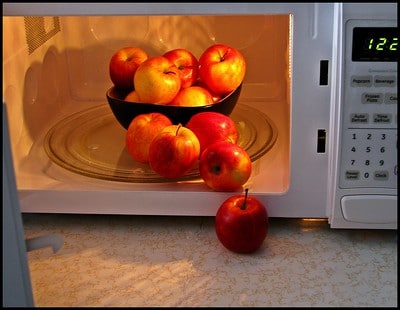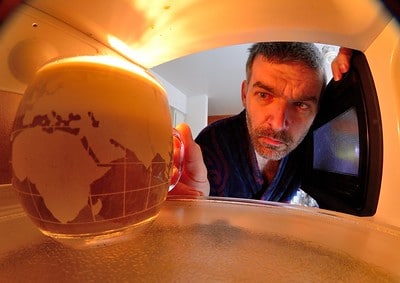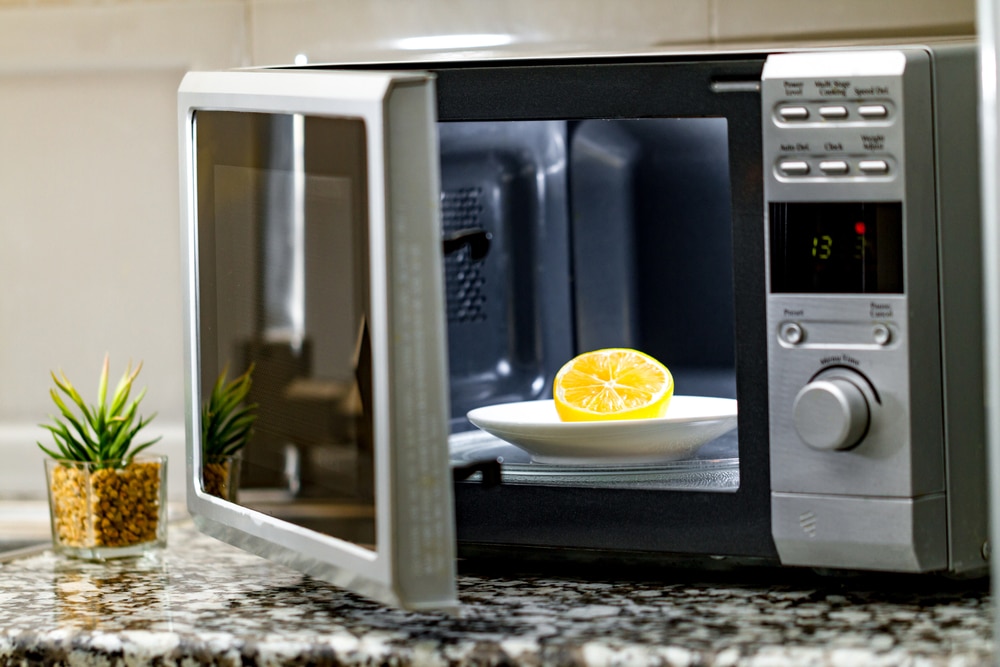Today, we take microwave ovens for granted. They are incredibly useful appliances that we can use to heat and cook food. Most homes have a microwave in addition to a conventional oven. But how does a microwave work? How do microwaves cook food?
Most people will not know the answer to these questions – they just know how to use one! This article answers these mind-boggling questions and looks at how microwaves heat food and when they were invented.
Microwave Radiation – The Basis of Microwave Heating
As the name implies, microwave ovens use microwaves to create heat energy. Microwaves are a type of electromagnetic radiation. They are electromagnetic waves and magnetic energy that move through space.
Electromagnetic radiation has a broad spectrum. This includes everything from long radio waves to short gamma rays. Microwaves are within this spectrum and are a form of non-ionising radiation. This means that they do not contain enough energy to change the formation of atoms within elements.
Aside from dielectric heating, microwaves are also used in many other ways. For example, uses of microwaves include speed cameras, and they are also used in telecommunication systems.
Microwave Ovens – Using a Microwave Generator to Cook Food
There are three main properties that make microwaves suitable for cooking food:
- They are reflected by metal.
- They can pass through various materials, including glass, paper, and plastic.
- They can be absorbed by food.
But how does this work, and how do microwave ovens cook food? We look at the two main processes below.
How Microwaves are Generated
Firstly, microwaves have to be generated for the cooking process. Microwave ovens work via the inclusion of a microwave generator called a magnetron. When the microwave oven is turned on, the magnetron takes electricity from the power source. Converting electricity, it then turns it into high-powered radio waves or microwaves. Therefore, a magnetron is used to generate microwaves.
How This Process Heats Food
Once the magnetron has generated microwaves, they must be directed towards the food. Firstly, the microwaves are pointed through a small channel known as a waveguide. This guide channels the waves into the main cooking chamber.
The microwaves bounce back and forth in the chamber due to the metal panels installed inside the walls. However, the microwaves do not bounce off of the food. Instead, microwaves pass inside the food.
The microwaves penetrate inside the food, and as they do, they make the food molecules inside vibrate quickly. The fast-vibrating molecules produce more energy and, thus, heat up. The more radio waves pass through the food, the more the molecules vibrate, and the hotter the food becomes. This is essentially the cooking process and how a microwave oven cooks food more quickly than conventional ovens.
Microwave ovens typically contain a rotating turntable to ensure the food cooks evenly. The microwave turntable spins slowly while the microwaves are being fired from the magnetron. This makes sure that they penetrate every part of the food and cook it throughout.
Why Some Materials Are Not Suitable for Use in a Microwave Oven
You undoubtedly know that you cannot place any material in a microwave oven. The accepted materials that are commonly placed in most microwaves include:
- Glass
- Ceramic
- Paper
- Plastic
These materials are usually acceptable because microwaves can pass through them. The waves simply pass through the containers and cook the food effectively. However, you should use plastic with care. Some plastics are not suitable for microwave use and will simply melt under intense heat transfer.
In contrast, you should not place metals and metal foil inside a microwave oven. The microwaves reflect on metals and metal foil and, thus, do not cook the food properly. Also, the constant reflection of waves from the walls and the containers can cause damage to the microwave oven cavity and electronics. Always check the instruction manual to see what materials can be placed inside your microwave.
The Benefits of a Microwave Oven
So why do we love microwaves? What makes them special compared to traditional ovens? The following are the main benefits:
1. They are more energy-efficient than traditional ovens.
Firstly, microwaves are generally energy-efficient. Conventional cooking is a lengthy process that uses a lot of gas and/or electricity. In contrast, microwaves do not use much electricity as the cooking time is far less. This makes them incredibly cost-effective.

2. They can cook food far quicker compared to conventional ovens.
Secondly, the microwave energy of microwave ovens can cook food much quicker than standard ovens. Often it takes hours to cook meals using a standard oven. In contrast, you can place food in a microwave and cook it in a matter of minutes.
3. The cooking process doesn’t reduce the nutritional value of food much.
Contrary to popular belief, microwaves do not greatly reduce the nutritional value of food either. Generally, this is because there is no need to add water to the food.
4. They take up far less space than a cooker.
Lastly, microwave ovens are much smaller in comparison to standard ovens. An oven requires a dedicated space in your kitchen. This usually reduces the amount of storage space you have. On the other hand, a microwave oven can sit neatly on your kitchen top!
When Was the First Microwave Oven Created?
The first experiments with microwaves for cooking are credited to Percy Spencer in 1939. Percy Spencer was an American inventor and physicist who worked for Raytheon. Raytheon was a company that worked for the U.S. Department of Defense, creating compact radar equipment.
One day, Spencer was building magnetrons. He happened to have a candy bar in his pocket. With the chocolate bar in his pocket unknowingly, he stood in front of an active radar set. Eventually, he noticed that the candy bar had melted.
After this incident, Spencer then went on to perform a variety of tests using different foods. This included popcorn kernels and eggs. While these experiments yielded interesting results (including an egg exploding in his colleague’s face!), they were uncontrolled.
As a result, Spencer created an enclosed metal box to which he attached an electromagnetic field generator. The magnetron blasted waves into the box, and thus, the first true microwave oven was born. Once this crude device was created, he experimented further in a controlled manner and tested different foods to observe the microwaves’ effects.
It was not until 1945 that Raytheon filed a patent for their microwave cooking oven – known as the Radarange. Compared to today’s compact appliances, this original microwave was 6ft tall, cost $5,000, and weighed 750lbs! Imagine trying to fit that in your kitchen? It took until 1967 for the first counter-top-sized microwave oven to be manufactured.
Are Microwave Ovens Safe?
Contrary to popular belief, the process of microwaving is actually safe. The microwaves are contained within the shell of the oven cavity and, thus, cannot escape. Microwave radiation can heat our body tissue. As a result, if the microwaves ever escaped, they could cause serious burns. However, this is highly unlikely.
The main safety issues from using microwave energy come from handling the food afterwards. Most injuries from microwave cooking are a result of burns. The burns typically result from handling hot food containers, exploding food, or exploding liquids.
Maintaining Your Microwave Oven
As mentioned, microwave radiation is only harmful when not contained within the microwave oven. As a result, you should periodically check your microwave for defects in the shielding and casing.
Check the latches, door hinges, and seals as these are potential areas that could degrade or break over time, allowing the escape of excess heat and radiation.
@jessicahaizman Follow for more deep cleaning tips! #deepclean #deepcleaning #cleanwithme #cleaning #cleanhome #cleanmicrowave #microwave #clean #cleaningtips #tips
♬ original sound – Jessica Haizman
Tips on Safe Microwave Oven Use
Below we have also provided some simple tips for your cooking compartment and using your microwave safely:
- Always read the manufacturer’s instructions fully. Make sure you are aware of the power rating of the microwave, and any safety instructions are given.
- Only use your microwave for cooking food that is suitable for microwave cooking.
- Do not stand against the oven or near it for prolonged periods while cooking.
- Never use microwave ovens if they operate while the door is open.
- Never heat liquids in a microwave for longer than the recommended time.
- Clean the inside of the cooking chamber regularly, including the cooking cavity and door.
- Only put plastic containers inside a microwave if they are listed as being microwave safe.
The best advice is to always cook food for the recommended time. If you cook it less, you risk food poisoning or diseases like salmonella. If you cook it too long, you risk burning the food, and it could explode. Also, it will be incredibly hot and could easily burn your hands and mouth.
Microwave Oven FAQs
Is microwave radiation harmful?
It can bring harm indirectly, but not in the physical sense. Microwave radiation can cause things to explode. However, it is not harmful to humans. Unlike X-rays which are a form of ionising radiation, microwaves are non-ionising and not capable of altering the atoms of cells in your body tissue. The harmful aspect of microwaves is that they can heat human tissue and, thus, cause burns.
Can you boil water and liquids in a microwave?
Yes, however, precautions should be made. This is because liquids like water boil unevenly in a microwave. To make sure the liquid is boiled properly, you should periodically remove it and stir it thoroughly.

You can also place a non-metallic object in the liquid container so that it doesn’t overheat.
How far do microwaves travel?
Microwaves travel via line-of-sight. They are not affected by diffraction and do not follow deviations in the Earth’s surface like hills or the curvature of the Earth. As a result, microwaves can generally travel as far as the visual horizon – approximately 40 miles.
A Fascinating Discovery
You should now have a clear answer to the question, how does a microwave work. This is an incredibly interesting subject, and as you can see, the creation of a microwave oven was purely by chance! If Percy Spencer had eaten that chocolate bar earlier, he might have never noticed the connection between microwaves and rapidly heating food!
Additional Resources
- How to Use a Knife Sharpener
- How to Dispose of a Microwave in the UK
- How to Whip Cream Using a Hand Mixer
- What Pans Can You Use on an Induction Hob
- How to Cook Pasta in the Microwave
Tom is a former chef turned full-time food blogger. He has always been passionate about food, and loves nothing more than experimenting in the kitchen and sharing his recipes with others. Tom’s blog is one of the most popular food blogs on the internet, and he has won numerous awards for his cooking. When he’s not blogging or cooking, Tom enjoys spending time with his wife and two young children.

